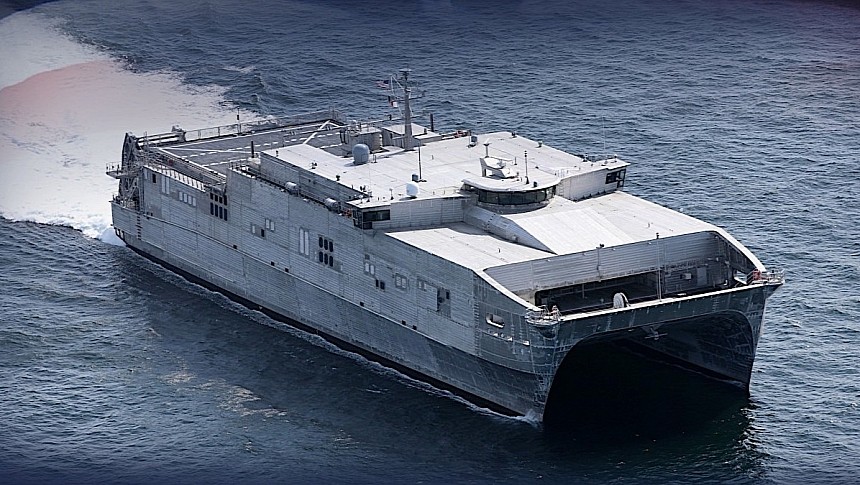At the end of December 2023, we got word of the U.S. Navy being on the verge of receiving three brand-new floating hospitals. They are the Expeditionary Medical Ships (EMS) being built by Austal, but they are not the only medically capable vessels to be requested by the military branch.
You see, the EMSs are based on something Austal calls the Expeditionary Fast Transport (EPF) platform. It forms the basis of the Navy's high-payload transport and logistics support capabilities – 13 of them are currently in operation.
The 14th is called the USNS Cody (EPF-14), and it was just delivered to the Navy for service earlier this month. Unlike its predecessors, though, this one is slightly different.
Cody is the first in a line of ships that will wear the Flight II designation. It means that in addition to its role of transport and support, it could also double as a hospital if the need arises.
More to the point, the ship has been designed to house two operating rooms, an onboard pharmacy, a blood bank, and even a lab. On top of all of that, Flight II EPFs will be able to support the landing of V22 Osprey helicopters and can launch and recover rigid inflatable boats (RHIBs) that play in the 11-meter (36-foot) class.
As for the ship itself, it is part of the Spearhead-class program that started 14 years ago. It comes in at 103 meters long (337 feet), and is powered by four MTU diesel engines. A total of 312 troops can embark on it, and they'll be moved to their areas of deployment (to distances as great as 1,380 miles/2,200 km) at speeds of 49 mph (79 kph). In standard configuration the ship can carry 600 short tons of cargo.
The Spearhead program calls for a total of 16 such ships to be constructed. The final two are already in the works at the Austal shipyard in Mobile Alabama. EPF-15 will be called USNS Point Loma, while the 16th still doesn't have a stage name. Each of the ships built for this effort has a cost of over $200 million.
USNS Cody was named after the city of Cody, Wyoming because, as Navy Secretary Richard Spencer said at the ship's christening, "the people of Cody are staunch supporters of a strong Navy and Marine Corps team."
As for the dedicated floating hospitals based on the EPF, they will be capable of transporting all the gear required for patient holding, stabilization, evacuation and transport. They too will allow the landing of helicopters, specifically the V-22 Osprey and CH-53K. Unlike the regular EPFs, they will however not have any weapons on board.
Work on these vessels won't start until the remaining two EPFs have cleared the shipyard.
The 14th is called the USNS Cody (EPF-14), and it was just delivered to the Navy for service earlier this month. Unlike its predecessors, though, this one is slightly different.
Cody is the first in a line of ships that will wear the Flight II designation. It means that in addition to its role of transport and support, it could also double as a hospital if the need arises.
More to the point, the ship has been designed to house two operating rooms, an onboard pharmacy, a blood bank, and even a lab. On top of all of that, Flight II EPFs will be able to support the landing of V22 Osprey helicopters and can launch and recover rigid inflatable boats (RHIBs) that play in the 11-meter (36-foot) class.
As for the ship itself, it is part of the Spearhead-class program that started 14 years ago. It comes in at 103 meters long (337 feet), and is powered by four MTU diesel engines. A total of 312 troops can embark on it, and they'll be moved to their areas of deployment (to distances as great as 1,380 miles/2,200 km) at speeds of 49 mph (79 kph). In standard configuration the ship can carry 600 short tons of cargo.
The Spearhead program calls for a total of 16 such ships to be constructed. The final two are already in the works at the Austal shipyard in Mobile Alabama. EPF-15 will be called USNS Point Loma, while the 16th still doesn't have a stage name. Each of the ships built for this effort has a cost of over $200 million.
USNS Cody was named after the city of Cody, Wyoming because, as Navy Secretary Richard Spencer said at the ship's christening, "the people of Cody are staunch supporters of a strong Navy and Marine Corps team."
As for the dedicated floating hospitals based on the EPF, they will be capable of transporting all the gear required for patient holding, stabilization, evacuation and transport. They too will allow the landing of helicopters, specifically the V-22 Osprey and CH-53K. Unlike the regular EPFs, they will however not have any weapons on board.
Work on these vessels won't start until the remaining two EPFs have cleared the shipyard.












